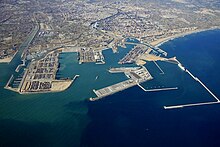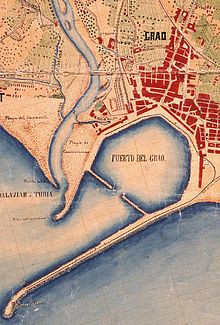Valencia port
| Valencia port | |||
|---|---|---|---|
| Data | |||
| UN / LOCODE | ES VLC | ||
| operator | Port of Valencia Authority | ||
| opening | Antiquity | ||
| Port type | Protective harbor | ||
| Throughput | 67 million t (2014) | ||
| Container (TEU) | 4.832 million TEU (2017) | ||
| website | http://www.valenciaport.com | ||
| Geographic information | |||
| place | Valencia | ||
| province | Valencia Province | ||
| Country | Spain | ||
| Valencia port | |||
| Coordinates | 39 ° 26 '24 " N , 0 ° 18' 57" W | ||
|
|||
The Port of Valencia , (Puerto de Valencia (es) or Port de València (es)) is the port and industrial area of the city of Valencia , Valencia Autonomous Province , Spain . It is one of the Spanish ports with the highest turnover, the second largest in the Mediterranean after Algeciras and the fifth largest container port in Europe.
geography
The port area of Valencia is located about seven kilometers southeast of the historic city center and is a pure port and industrial area on the Mediterranean . To the south it is bounded by the mouth of the Rio Turia . The almost 7 km² port area is divided into several areas. In the far north is the Marina Real Juan Carlos I for private yachts. To the south joins the Moll de Ponent , which in the western basin is mainly used by commercial passenger shipping , ferries , tour and cruise ships . The eastern basin there is used for container handling. Further south there are three more docks of the Port de Valencia ; the two western ones are also used for container handling, the eastern one for handling liquid goods. Spatially clearly separated, the El Grau storage area extends to the very south and the marinas of the Real Club Náutico de Valencia with several thousand water berths are located directly at the mouth of the Turia .
Economically, the port of Valencia also includes the two "satellite" ports of Sagunto, 25 kilometers to the north, and of Gandia , 50 kilometers to the south.
history
Already in the Neolithic and the Copper Age, coastal shipping was practiced in the area. As the evaluations of archaeological finds show, a considerable amount of seafood and sea fish was consumed, meaning that fishing was carried out at least near the coast. The sea level at that time was about five to seven meters lower than today, the coastline was two to three kilometers further east and the estuaries were further north.
A Greek colony ( Zakantha ) had existed in Sagunt since the 8th century BC . Agricultural products, especially grain, were shipped and other far-reaching trade relationships were maintained, for example copper ore imported from Cyprus. Around 250 BC Then the seafaring Carthaginians dominated the area and used the estuaries of the rivers as landings.
The first fortified structures emerged from 140 BC. In the Roman Republic after Emperor Callaicus conquered the area. The fertile estuaries of the rivers were considered to be one of the granaries of the Roman Empire until the Roman era ended between AD 460 and 470 and the Visigoths settled there.
Around 711 the area came under Muslim influence and remained with the Caliphate of Cordoba in the High Middle Ages . In the middle of the 11th century it came to the Crown of Aragon and flourished from the 12th century to one of the hubs of the global silk trade .
In the 15th century, the port facilities of Valencia became an important base for the Mediterranean fleet and the defense against the Ottoman Empire .
In the Spanish colonial period , the military importance gradually declined or transferred to Gibraltar , but remained a location until the Napoleonic period .
During the Second World War and under the Franco regime , the military importance of the base revived.
After a catastrophic flood in 1957, the course of the Turia River was relocated south in the early 1960s and the port facilities were commercially restructured and expanded.
Commerce and infrastructure
Today the port of Valencia has more than 12 kilometers of quays and berths . Four kilometers of the piers allow a discharge depth of 14 meters.
The port is a major employer and induces 15,000 jobs in the metropolitan area of the large city of Valencia.
In 2014, a total of 67 million tonnes of goods were handled in the port of Valencia, including 4.4 million TEU in containers and 400,000 tonnes of fishery products . 7,370 ships were handled and the number of passengers was almost 400,000 travelers. The port of Valencia also allows regular passenger traffic with the Balearic Islands and Italy .
traffic
District roads open up the port area to the motorway-like V 15. Sidings cause rolling of the RENFE partially down to the piers .
Local public transport connects the port area with the city center with bus lines and from there to Valencia Airport, 15 kilometers away .




